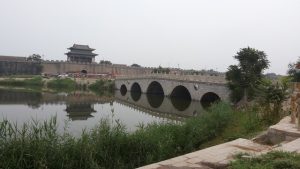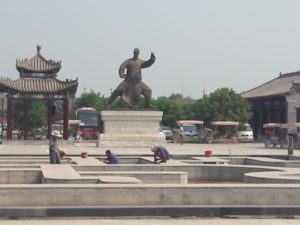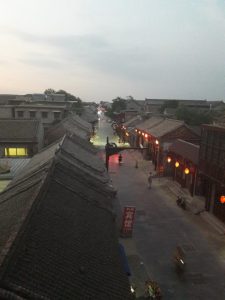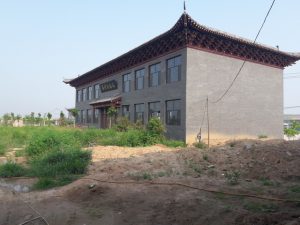This contribution is a short overview of Guangfu’s taijiquan 广府太极拳 practices and the political transformations happening in this town located in the North China region. A first version of this contribution was published in Chinese as an afterword in Sun Jianguo’s taijiquan manual (Sun 2018: 259-261). Master Sun 孙建国 – a taijiquan master native of Guangfu – invited me to write down “what I saw and heard” 所见所闻 during my stay at this site. The original text focused on Master Sun’s views on taijiquan’s recent developments and the political processes framing the local development of Guangfu. Here, I will also share observations of another taijiquan master – Yang Zhenhe 杨振河 – and his group of disciples.
Guangfu Township is located in the district of Yongnian 永年县, south of Hebei province 河北省. It is the epicenter of the North China flatlands, situated at the crossroads of transportation routes between Hebei and Henan 河南 provinces (i.e. North to South), and between Shanxi 陕西 and Shandong 山东 provinces (respectively West to East). According to Douglas Wile, the region was the “traditional hotbeds of sectarian rebellion” from the Han Dynasty until the very late Qing (Wile 1996: 5). Today, visitors can still walk around its defensive walls and the old town which has been kept safe within it. In many ways, Guangfu is really an “old city” 古城. The district of Yongnian, to which Guangfu belongs, is located in the center of the “alluvial flood plain of the Yellow River [that] stretches flat for hundreds of miles” (op.cit.: 7). In order to control water flows and irrigate the fields, a dense network of canals and ponds can be seen all across the countryside. A large moat also surrounds the high walls of the fort, which had given Guangfu the alias of “The City of Water” 水城. Finally, Guangfu is the hometown of Yang Luchan 杨露禅and Wu Yuxiang, 武禹襄who are respectively the founders of the Yang and Wu lineages of taijiquan. During the late 19th and the 20th centuries, these two hand-combat systems spread throughout China and worldwide, giving their two founders a well-known reputation. For these reasons, their hometown is also often referred to as the “The City of Taiji” 太极城.

In 2006 and 2008, the authorities of the Yongnian District have registered the Yang and Wu lineages of taijiquan as Intangible Cultural Heritage (ICH) at the national level (Chinese ICH Website 2018). These body gestures and their representations embed new symbolic meanings in the construction of Chinese identity. They have become cultural goods “reflecting the values and spirit of the Chinese nation” (Bodelec 2014: 19). Between the 3rd and 9th of August 2018, I led an ethnographic survey in Guangfu. In short, I wanted to observe the processes by which Chinese State institutions are reclaiming meaning over the popular practice of taijiquan, and framing it into a nationally shared cultural heritage. I was especially curious about the potential impact of such policies on practitioners’ habits and views, and whether such changes could be observed through a focus on Chinese martial body technics and their associated meanings, as they circulate within distinct frameworks, being either created, dissipated or conserved (Zimmermann and Nova 2015)[1].
When I arrived in Guangfu, I was initially looking for Master Yang Zhenhe 杨振河, who is the national inheritor and 5th generation of the Yang lineage. After a few days in Guangfu, while I was visiting the house of Wu Yuxiang (which has been turned into a museum), I had an opportunity to meet with Master Sun Jianguo, a 5th generation master of the Wu lineage and inheritor at the district level. Eventually, I could conduct extensive interviews and observations with these two masters, as well as their close disciples. I was also able to meet with representatives of Yongnian District’s Cultural Bureau (in charge of the ICH program) and Sport Bureau (in charge of martial arts).
According to these local actors, the authorities of Handan Municipality 邯郸市 started in 1997 to visit Guangfu township regularly, and a “touristic development” 旅游开发 was planned for the area. Authorities first renovated the defensive wall and important historical buildings, such as the household and temple of the Wu family. In this project, the practice of taijiquan had, from the very beginning, a central role. Authorities identified taijiquan as the main attraction of the area. At that time Yang Zhenhe was already a well-established master, and he was naturally involved in the government program. Later, in 2005, he was selected as a national inheritor at the very beginning of the ICH program. Partly as a result of these policies, Yang Zhenhe has been able to open – with the help of his disciples – affiliated schools around China and in Europa. He travels regularly to teach in these schools (although he only gives conferences and does not teach by himself). Throughout the years, Yang Zhenhe has compiled a new set of 38 technics – published in manuals and on DVD – that his disciples promote through their teaching but also during competitions. By comparison, Sun Jianguo, in the late 1990s, traveled around China and visited taijiquan communities in order to make a reputation for himself and hopefully recruit disciples. When he returned to Guangfu in 2001, he didn’t immediately see the benefit of the ICH program and ignored it at the start. As a result, Sun Jianguo was only recognized at the district level very late in the process. In order to progress to the provincial and national level, he must now broaden the scale of his transmission by publishing books, participating in seminars, training students around the country and abroad, etc.
In the local narratives, Guangfu is referred as the “Taiji Township” 太极之乡. At the governance level, taijiquan has clearly become a marketing argument in the tourism industry. An imposing statue of Yang Luchan stands in front of the south gate dominating the “Taiji Esplanade” 太极广成 from where visitors can access all kinds of outdoor activities, such as paddle boats or bicycle rides. The “taiji symbol” 太极图 covers up sidewalks, street signs and buildings’ facades. In the main street of the city, shops sells taijiquan “goodies” and numerous facades advertise taijiquan related “research institutes” 研究院. In addition, visitors can also enjoy numerous leisure activities not related to taijiquan. For instance, in front of the east gate, a new block has been built to provide facilities for the visitors, where many hotels and restaurants, but also a Taoist temple and the Museum of agrarian life, are part of this new area. In the evening, the main street is full of visitors from the nearby townships, who come to enjoy the variety of street food and nightlife activities. In front of the west gate, a large “Water World“ 水世界 provides swimming pools and water slides. This touristic development is still in progress, as several blocks between the east and north gates have been demolished and were being built anew at the time of the survey.


Intriguingly, despite the centrality of taijiquan within the official narrative, its practice is somehow confined to the private sphere. During my stay in Guangfu, I visited three schools – all of which were located in the teachers’ private house – and where training usually took place in the intimacy of the internal court. Sun Jianguo told me that he wouldn’t lightly perform publicly some specific technics which he considers a secret to be kept. In other words, through the long period of touristic development in Guangfu, the practice of taijiquan has so far remained something shared in the limited scope of the relationship between a master and his disciples. However, the situation might be evolving. Yang Zhenhe is currently building his first training center of Guangfu. Composed of a big training hall, dorm and canteen, the facility is comparable to those I visited in Cangzhou city and the plan is to provide an all-inclusive training experience for outside practitioners.

During the fieldwork, I was able to attend training sessions within the local community. The two daughters of Yang Zhenhe – Yang Lijuan 杨丽娟 and Yang Lifen 杨丽粉– were leading a morning training session for around twenty local students on a daily basis. The group was almost entirely composed of female students who had started together to learn the basic sequence of Yang Zhenhe’s system a few months earlier. More advanced students were occasionally also joining the group. Yang Jianchao 杨建超, their younger brother, also joined the sessions during the weekend when his work allowed him to return to Guangfu from Handan City.
Overall, the training sessions followed a well-established procedure. At 5am, Yang Lijuan, the younger daughter would walk around the defensive wall as a warm-up, before gathering with her older sister and the rest of the group at 6am. After a short stretching, the two sisters performed a sequence of movements along with the group. When completed, they gave explanations on specific gestures. Sometimes, one of the teachers looked at the students while they performed, and provided individual feedback. After a short break, the group started the sequence again. These sessions lasted between 40 and 60 minutes on average. According to Yang Lijuan, this kind of training session is meant to familiarize the students with a whole sequence, and they usually need about one month to learn a new sequence in its entirety.

Yang Lijuan told me that practitioners would also train in the evening, but this time individually at home. I witnessed this kind of informal training at the house of Sun Jianguo. During the few days I spent with this master, I had the opportunity to observe that he received a lot of visits in his everyday life. The first day I met him, as we were discussing in his office, a group of three persons came to proposition him to teach taijiquan in a wellness center which they had just opened in Handan City. Another day, a student from a nearby village came to Sun Jianguo’s office to ask a specific question about taijiquan technics. One evening, a student from Guangfu was helping Sun Jianguo to digitalize documents for an upcoming publication. During these visits, Sun Jianguo would share his knowledge through an informal process, mixing discussion of taijiquan’s principles with technical application on the student. These examples were similar to what Jean-Marc De Grave has described as a traditional transmission framework (De Grave 2007), that is, a practice rooted in a local community with strong interpersonal relationships between a master and his disciples. On a more personal perspective, these trainings were different in my eyes as being not as precisely scheduled and structured as the ones I observed in sport teams as a practitioner myself.
In this short contribution, I have attempted to provide an illustration of how the practice of taijiquan is commoditized within the development strategy of the local authorities of Guangfu Township. This process is taking place within a large strategy of instrumental use of “popular culture” 民间风俗 led by the Chinese government since the foundation of the People’s Republic of China in 1949 (Graezer Bideau : 2008). This cultural policy has led to the standardization of popular practices into nationally shared and politically correct forms (Durand-Dastès 2014, Graezer Bideau 2008, Micollier 2007, Graezer 2003). Since 1958, the Chinese Wushu Association has massively promoted martial arts related sports disciplines (Song et al. 2016: 30), while proscribing elements labeled as “feudal” 封建 or “sectarian” 宗派 (Chinese Wushu Association 2016). Authorities are thus reshaping Chinese martial arts through a so-called “modern” perspective, formalizing the basis of what is described as a physical education by setting competition regulations and physical preparation (warm-up, gymnic conception of movements, rationalized teaching method/pedagogy, etc. See Jiang, 1995). This political leadership over martial arts has led to the creation of a wushu sport category, intermingled with the Olympic ideology (Lu and Hong 2014, Theeboom et al. 2017).
Through this process, body technics and their related representations underwent profound modifications. In the traditional taijiquan lineages, knowledge is legitimized by the persona of the master, and his or her belonging to the genealogy (typically, back to the founder of the style). In sports, this knowledge is usually legitimized by national standards and regulations. Moreover, elite athletes, when performing movements, concentrate on criterion used by competition referees – essentially aesthetic considerations. On the contrary, practitioners in traditional lineages concentrate on combat efficiency. In this context, according to the practitioners themselves, the “flavor” 风格 of taijiquan has changed: it has shifted from a hand-combat system to a “taiji gymnastic” 太极操, or a “taiji dance” 太极舞.
In the case of Guangfu Township, one can argue that it is not the body technics that became the cultural goods sustaining the tourist industry, but rather the narratives related to taijiquan and the historical sites of the township. The visitor is left to wonder where the practice of taijiquan is actually located. Indeed, according to the district Sport Bureau, there are around 25 taijiquan schools in Guangfu that train from 50 to 100 local students each. But these practitioners rarely train in public spaces so far and local schools don’t provide any infrastructure to welcome outside students (except the one currently being built which I described above). The body technics are thus more or less confined to the intimacy of master’s courtyards and their direct relationships networks, as we saw in the case of Sun Jianguo’s daily habits.
Finally, the story of Sun Jianguo himself provides a vivid example of what Christiana Maags refers to as a “race to the top” (Maags 2018). In the current ICH system, practitioners are competing over their recognition as “transmitters” 传承人 of the heritage. The stakes are high since the transmitter receives institutional back up and subsidies from state institutions, allowing her or him to develop further the practice. In order to be recognized, practitioners must provide evidence of their belonging to the practice community, as well as the importance of their transmission (often measured with quantitative criteria such as the number of years, number of students, number of schools and the geographical scope of the transmission). Moreover, this process is happening on multiple levels of a complex Chinese administration, where a master has to climb the ladder from district level to provincial level, and finally national level.
This contribution was reviewed by Pascale BUGNON.
Suggested Citation:
PORCHET, Pierrick (2019). « An Ethnographic Survey in Guangfu “Taiji Township“ ». In Blog Scientifique de l’Institut Confucius, Université de Genève. Permanent link: https://ic.unige.ch/?p=1213, accessed 12/13/2025.
References:
Bodelec, Caroline. 2014. “Être une grande nation culturelle. Les enjeux du patrimoine culturel immatériel pour la Chine“. Tsanta 19: 19‑30.
Chinese ICH Website中国非物质文化遗产网,2018。国家名录。URL : http://www.ihchina.cn/5/5_1.html, consulted on 2018.08.15.
Chinese Wushu Association中国武术协会官方网站,2016。武德守则。URL : http://zgwx.wushu.com.cn/w_wdsz.asp, consulted on 2018.08.15.
De Grave, Jean-Marc. 2007. “L’initiation Rituelle Javanaise et Ses Modes de Transmission: Opposition Entre Javanisme et Islam.” Techniques & Culture [en ligne] 48–49: 1–28.
Durand-Dastes, Vincent. 2014. “La Grande muraille des contes“. Carreau de la BULAC: 1‑57.
Graezer, Florence. 2003. “Le Festival de Miaofeng shan: culture populaire et politique culturelle“. Études chinoises 22: 283‑95.
Graezer Bideau, Florence. 2008. “L’instrumentalisation de la culture populaire. Le cas de la danse du yangge en Chine“. Tsantsa 13: 52‑60.
Jiang Bailong 江百龙. 1995. Wushu lilun jichu 武术理论基础. Renmin tiyu chubanshe 人民体育出版社: Beijing 北京.
Lu, Zhouxiang and Hong Fan. 2014. Sport and Nationalism in China. Routledge: New York.
Maags, Christina. 2018. “Creating a Race to the Top: Hierarchies and Competitions within the Chinese ICH Transmitters System.” In Chinese Heritage in the Making: Experiences, Negotiations and Contestations, edited by C. Maags and M. Svensson. Amsterdam: 121-144
Micollier, Evelyne. 2007. “Qigong et “nouvelles religions“ en Chine et à Taiwan: instrumentalisation politique et processus de légitimation des pratiques“. Autrepart 2(42): 129‑46.
Song, Jie, and Hongli Yue. 2016. “Considerations on Wushu’s National Culture Characteristics“. Asia Pacific Journal of Sport and Social Sciences 5(1): 28‑34.
Sun Jianguo 孙建国. 2018. Wu shi taijiquan : shijian bian 武氏家传太极拳:实践篇,Renmin tiyu chubanshe 人民体育出版社: Beijing 北京。
Theeboom, Marc, Dong Zhu, and Jikkemien Vertonghen. 2017. “‘Wushu Belongs to the World‘. But the Gold Goes to China…: The International Development of the Chinese Martial Arts.” International Review for the Sociology of Sport 52(1): 3–23.
Wile, Douglas. 1996. Lost T’ai-chi Classics from the Late Ch’ing Dynasty. University of New York Press: Albany State.
Zimmermann, Basile and Nicolas Nova. 2015. “Circulation: A Theoretical Toolkit.” Design and Culture 7(2):167–84.
[1] This survey is part of a doctoral research project registered in the University of Geneva and directly supported by the Institut Confucius at the University of Geneva.
